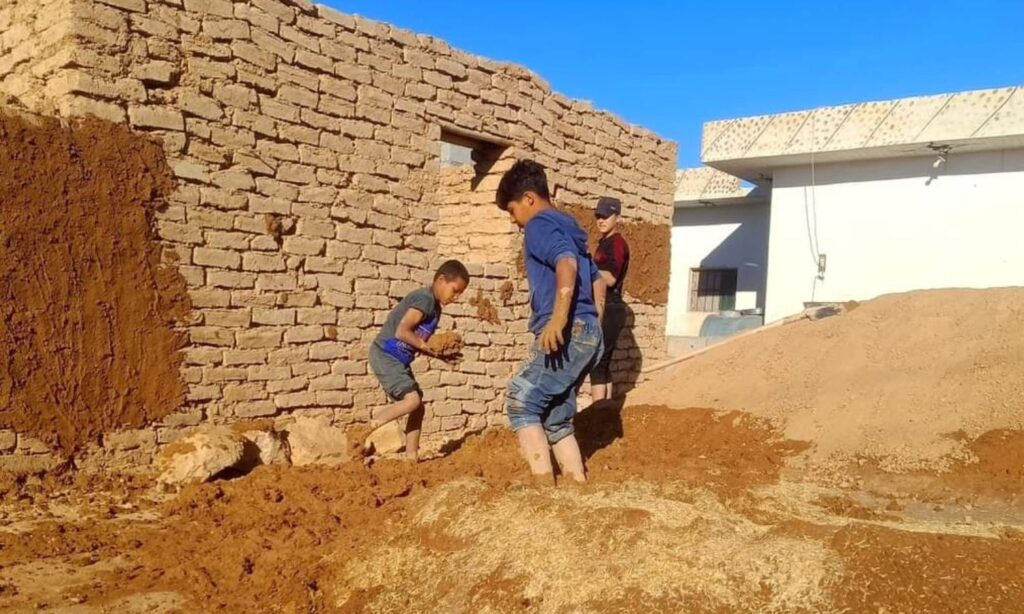Deir Ezzor – Obadah al-Sheikh
The harsh economic and living conditions have pushed residents in the countryside of Deir Ezzor to return to building with clay bricks after years of neglect. They found it to be the most economical solution amid rising construction material prices.
The trade of clay brick making had declined before the Syrian revolution in 2011, but it returned as the war intensified and military operations forced residents to revert to primitive building methods.
Soil, water, and straw
For the past seven years, Hamed al-Saho has turned to making clay bricks in the town of al-Izbah in northern Deir Ezzor to support his family of nine.
Al-Saho formed a construction workshop with his brothers and relatives, consisting of four workers, and started practicing this profession, which he said requires no capital—just soil, water, and a little straw, noting an increasing demand for clay bricks.
He mentioned to Enab Baladi that he and his workers cut approximately 1,000 clay bricks a day, adding that the daily wage for the entire workshop could reach around 50 USD.
The production of clay bricks relies on natural materials: soil, straw, and skilled labor. It begins by soaking a specific type of soil in water, locally known as “al-Harri,” which is then mixed with straw and left for several hours before being properly mixed, allowing the workers to cut it into molds made of wood, with measurements based on demand.
On his part, Horan al-Shahadah, a clay brick workshop owner from the town of Mu’azilah in northern Deir Ezzor, stated that he charges 75 USD for every 1,000 clay bricks.
From that amount, he covers the cost of materials (soil, water, and straw) and the wages of his five workers, paying each worker 100,000 Syrian pounds daily (about 7 USD).
Al-Shahadah previously worked in construction, but the decline in building activity forced him to look for new work, lacking a “wasta” (connections) for construction contracts with the Civil Council or oil fields.
Al-Shahadah noted that demand for clay bricks is increasing due to the high prices of building materials, making it difficult for low-income individuals to build even small rooms. He pointed out that houses made of clay bricks are cool in summer and warm in winter.
Lower costs
Ramzi al-Nabki built a two-room house from clay bricks in the town of al-Tawamiya in northern Deir Ezzor, stating to Enab Baladi that he chose this type of construction to save money and complete his marriage project.
Al-Nabki explained that building the two rooms cost him a quarter of the price of a room made of concrete and steel, which he sees as a fitting choice with his monthly income, as he earns one million Syrian pounds (65 USD).
Workshop owner Hamid al-Saho emphasized that the clay brick industry has revived due to the high prices of construction materials like cement, concrete blocks, and steel. The cost of building a three-room house may not exceed 2,000 USD, with roofs made of wood and tarpaulin.
In comparison, the cost for the same construction using concrete and steel could reach about 7,000 USD, with the price of a ton of Iraqi cement at 125 USD, a ton of European steel at 900 USD, and 100 concrete blocks costing 25 USD.
Building houses from clay bricks is a viable option amid rising costs and limited job opportunities in a predominantly agricultural area, where daily labor wages range between 25,000 and 100,000 Syrian pounds, depending on the type of work and hours worked, while the minimum salary for Autonomous Administration (AANES) employees is about one million Syrian pounds (65 USD).
This trend is not limited to Deir Ezzor; the reliance on clay bricks as an economical and sustainable alternative is prevalent in most rural areas of northeastern Syria.
Building homes using clay bricks is one of the oldest construction methods in the region, but returning to it today has become a response to economic challenges and a need for solutions that better align with the harshly hot summers and cold winters of the surrounding environment.

